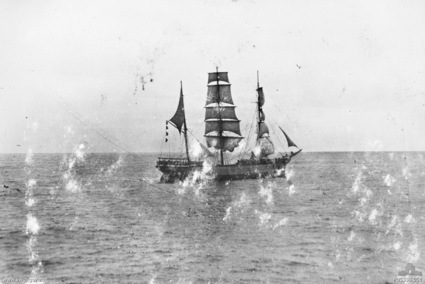|
Letters
Captain John Barnes Rugg was skipper of the "Dee", one of the many vessels captured by the Wolf
January 27, 2010
Greetings Mac -
I wanted to extend a personal thanks to your historical works concerning WWI and WWII. Specifically with regards the exploits of the German Raider "Wolf" in 1917. The pictures you posted online are fantastic.
Captain John Barnes Rugg, my Great Uncle (my Grandfather Edgar Rugg's brother), was skipper of the "Dee", one of
the many vessels captured by the Wolf and its captain Karl Nerger. Capt Rugg was a life-long master mariner, beloved by his crew, and experienced much sadness watching on as the Dee was scuttled by the Wolf.
Are these the only pictures you have from the Wolf and its inhabitants? I see you have pictures from several crews of other ships intercepted by the Wolf, such as the Jumma. None perhaps of the Dee and its crew and / or captain? She was a fully-rigged 3 masted sail, porting from Mauritius as I mentioned.
Kind Regards,
Kevin William Kellar
Kevin,
Thank you for your kind comments about AHOY.
Here is a picture of DEE

AWM Collection Record: P05338.051
ID Number: P05338.051
Maker: Unknown
Place made: Indian Ocean
Date made: 30 March 1917
Physical description: Black & white
Summary: Starboard side view of the 1169 ton
British three-mast schooner, Dee, captured and sunk
using explosive charges by the German armed merchant
raider, SMS Wolf, 410 miles from Cape Leeuwin,
Western Australia. Her crew of 19, mostly teenage
boys from Mauritius, were transferred aboard the SMS
Wolf before the Dee was scuttled. This image is from
a collection relating to the voyage of the German
raider, SMS Wolf (II), and was taken by an
unidentified crew member. Previously a freighter of
the Hansa Line, with a gross tonnage of 5809 tons,
she was launched as 'Watchfels' and was renamed SMS
Wolf when she was fitted out as an auxiliary
cruiser. She was prepared for her role as an armed
merchant ship with an armament that included six
150mm guns, one 105mm gun, three 52mm guns, four
torpedo tubes and carried 458 mines, to be placed in
Allied territory throughout her journey. SMS Wolf
was also provided with an innovative new weapon, the
Friedrichshafen FF.33e two seater biplane, an
aircraft that was used with deadly success to scout
out new targets for attack or to elude enemy
threats. The raider was relatively slow, with a top
speed of only 11 knots but her bunkers held 8000
tons of coal, giving her a huge cruising range of
32000 nautical miles at eight knots. On 30 November
1916, SMS Wolf sailed from Kiel, Germany, with a
complement of 348 sailors and commanded by
Fregattenkapitän (Commander) Karl August Nerger.
During the 451 days she was deployed in Allied
territory around Australia, New Zealand, New Guinea,
South Asia and Africa, she destroyed 35 trading
vessels and two war ships, amounting to
approximately 110000 tons. She returned to Kiel on
24 February 1918 with 467 prisoners of war and
substantial quantities of rubber, copper, zinc,
brass, silk, copra, cocoa and other essential
materials to the German war effort. SMS Wolf,
without any support, had made the longest voyage of
a warship during the First World War. On her return
to Germany, the Kaiser presented every crew member
with the Iron Cross and Fregattenkapitän Nerger was
awarded the highest German decoration, the Pour le
Mérite.
Copyright: Copyright expired - public domain
Have you seen the recently published book The Wolf by Richard Guilliatt and Peter Hohnen. William Heinemann Australia 2009?
Best regards,
Mac.
back to letters index
|
|
|

